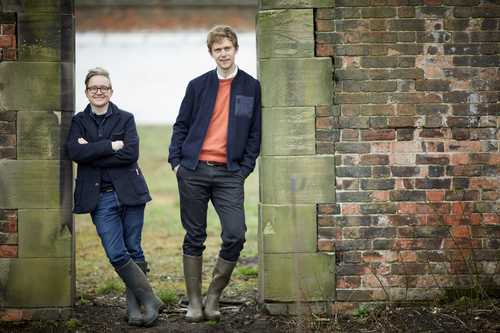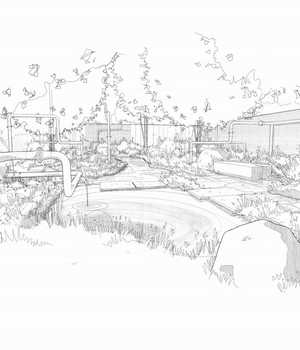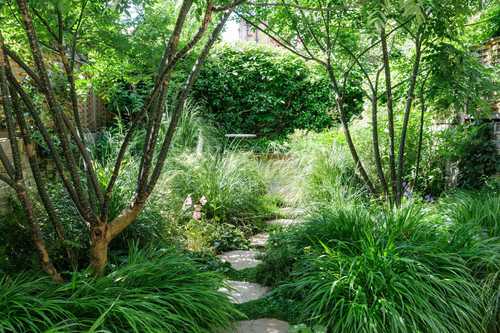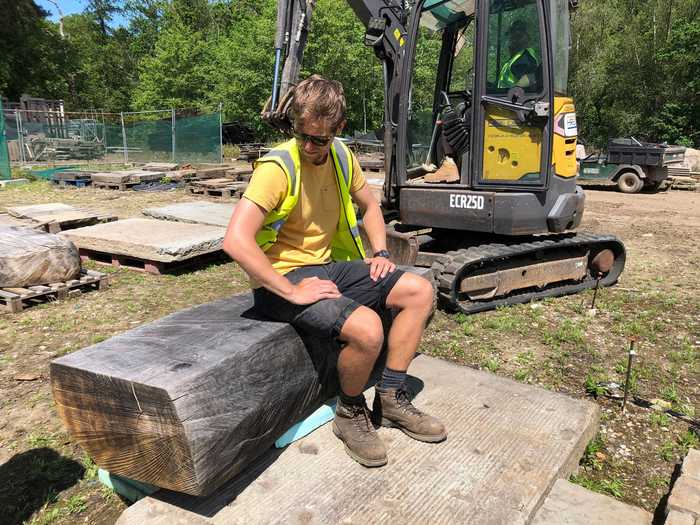Have a seat with...
Hugo Bugg
Hugo Bugg is one half of Harris-Bugg Studio, however his expertise doesn't stop there; Hugo is not only the youngest ever gold medal winner at the Chelsea Flower Show, but he has also previously been named RHS Young Designer of the Year.
In this Have A Seat With, we talk all things Chelsea Flower Show, designing the stunning kitchen garden at RHS Bridgewater, and his Devon influences. A truly varied and fascinating read.
Hi Hugo, thanks for taking the time to sit down with us! You’ve been busy at RHS Bridgewater recently, tell us about the project there.

We were selected to design the Kitchen Garden at RHS Bridgewater following a national competition. Our intention was to take visitors on both a historical and horticultural journey by creating a productive space with a design inspired by the rich heritage of Bridgewater’s surroundings. The main pathways of the garden are inspired by the route of the Bridgewater Canal - the construction of which marked the beginning of the golden age of canals and were the lifeblood of the Industrial Revolution in Greater Manchester.
The smaller pathways and layout of the beds follow the pattern of local field boundaries of the exact area at that time, found in historic Ordnance Survey maps of the 1890s. By using smaller pathways we can allow visitors to get up close to the planting. The garden is an experimental productive space that will evolve and develop over time. It has four distinct zones - an edible forest garden, a formal kitchen garden, and a herbal garden. The fourth zone celebrates fruit training and weaves around the historic walls. There are 106 trees on the walls, ranging from apples, plums and gages to pears, cherries and apricots.
"Entering Young Designer of the Year was a really fantastic experience, and one I will always remember. It was my first ever real life garden."
What did being named the RHS Young Designer of the year in 2010 mean for you and your career? It must have been such an amazing moment!
Entering Young Designer of the Year was a really fantastic experience, and one I will always remember. It was my first ever real life garden. I finished university with a great paper portfolio but I soon realised you can’t win projects with a portfolio, so entering the competition enabled me to design and complete a real garden. I took part straight from university, I had no money, I camped at the show ground and ate baked beans almost every day. When I won a gold medal, Best in Show and Young Designer of the Year it was very surreal - I was tired and emotional and so happy and proud. Looking back though, it really was an important platform to starting my own practice, entering more shows and winning projects.

You’re the youngest ever gold medal winner at the Chelsea Flower Show, which is a huge achievement. What advice would you have for young designers just starting out?
When it comes to creating show gardens it is very important to build the right team around you. You need a fantastic nursery growing your plants, the best construction company and engineers. You need to set out to create a ‘dream team’ because you can’t do it by yourself. Creating that team to support you and to critique your work - that’s the foundation to building a really successful show garden.
I would also say it’s worth saying yes to all sorts of different opportunities. I realised quite early on that I was being asked to do gardens, shows and competitions and they were all really important in terms of establishing my practice.
Thanks for that amazing advice! So, what led you to start up Harris-Bugg studio?
I was working as a solo designer and being asked to work on more and more complex projects. I was looking for someone to work with me in Jordan and Charlotte came highly recommended. She worked with me and the rest of the team for about a year there. During that time working together I found myself asking Charlotte for her thoughts on many of my other projects and she started doing the same for her projects. We got to a point where we realised we could achieve so much more combining forces. Our design partnership is based on valuing each other’s opinions and always wanting to create the best possible gardens we can.
" Over time we created mixed borders, lawned areas, a lawned tennis court and a small woodland garden. It was a magical time."
What is your earliest memory of gardening?
Definitely with my father. We moved to Devon when I was about four years old and built a house on a plot of land near Lyme Regis. I remember every weekend and after school helping my Dad to clear the garden with a scythe and hoe. It was very overgrown. Over time we created mixed borders, lawned areas, a lawned tennis court and a small woodland garden. It was a magical time.
Those sound like such special memories! What made you realise that you wanted a career in landscape design?
I think it links back to the previous question about spending so much time as a child with my father in the garden. I loved being outside, I loved the natural environment. I got a dog when I was really small and I loved walking. I still love walking and being in wild landscapes. When I was looking to go to university and thinking about what opportunities there were I saw that there was a garden design course at Falmouth. I knew Cornwall well already and I thought it would be an amazing place to live as well as the course offering a chance to be creative as well as working with nature.
Your work spans across Europe, which is fascinating to follow. Is there much of a culture difference to garden design or different emphasis across the continent or does it follow similar conventions to the UK?
Our approach is always about immersing ourselves in the locality of a landscape - wherever it is located. Charlotte and I talk about a ‘signature approach’ to design rather than a ‘signature style’. This means we really get to know, and think about the local stories that connect to a landscape - its history, geology, anthropology. For instance, working in Jordan we spent a lot of time getting to know the landscape and talking with the client, working with the existing team. We did lots of listening to make sure we were designing for the needs of the visitors who were going to be going there. We ran workshops with schools and local people and met the local Bedouin families. We wanted them to feel engaged with the project and to have a sense of ownership of the garden. For us, that is a sign of a successful garden.

Tell us about what it was like to be commissioned as the designer of the first Royal Botanic Gardens in Jordan! How did you go about designing a 400 acre garden in the mountains?
It was a huge privilege and honour to be asked. I remember at the time Jordan represented this amazing country that I really wanted to visit. When I arrived the site was just so spectacular. It is located on a very steep hillside with a reservoir at the bottom - the views are breathtaking! The site had been fenced off from grazing for 10 years before I got there so the wild flowers and vegetation had already been restored. As a project it was quite daunting, a vast challenge and something I had never done before. At the same time it was really exciting to be building a team around me both in Jordan and the UK to masterplan and go through the conceptual design for the project. The Princess of Jordan had an amazing vision for the gardens to be inspired by sacred Islamic arts and to re-establish five keys habitats found across Jordan. Working to deliver that brief, interrogating the business plan, doing visitor profiling and working with local Jordanians to achieve the Princess’s overall vision was very memorable - a once in a lifetime opportunity.
You give a lot of lectures and seminars, what would you say is the main message you want to get across to people in the audience?
We thoroughly enjoy talking to people about our work and sharing our enthusiasm for the projects we are working on. We want to inspire people rising up in the profession about the contribution they can make and to prompt conversations about the importance of access to green space, biodiversity, green infrastructure and sustainability. As a studio we are always looking for opportunities to collaborate with other design professionals - architects, engineers, horticulturalists - and believe by working together as larger teams we can have more of an impact on how we create the the places we live, work and visit. Our vision for the pocket park garden we have designed for this year’s Chelsea Flower Show encapsulates one of the messages we want to get across to people - that any small, neglected space can be transformed into something beautiful and restorative for people and wildlife to share.
We know your roots are in the beautiful Devon countryside. Do you feel it is important to incorporate nature into urban environments? How best do you think we can do this?
I feel very fortunate to live in Devon with its diversity of natural landscapes on my doorstep. I live at the moment in the centre of Exeter and we have a studio in London, where I spend a lot of time. I feel strongly about the need to have nature in cities for so many different reasons - be it environmental, social or for health and well-being reasons. Green spaces should be treated as vital infrastructure, just like power and water. We need to create green corridors for wildlife and biodiversity, to promote urban cooling and as flood control as well as giving people from all walks of life the opportunity to experience the many health and wellbeing benefits that come from being in nature.
How can furniture be incorporated in to garden design? Are there any rules to abide by?
Furniture is really important in a garden - it’s the place where you sit, rest and enjoy your garden or being in nature. It’s important to consider the right piece of garden furniture for the setting and how you are going to use your garden. Table and chairs are needed for dining, comfy chairs for sitting for long periods and simple benches and seats for short periods of sitting. Gardens are about the planting and nature so furniture should complement that and not compete with it. Style and materiality of furniture is important - natural materials such as wood are very tactile and subconsciously connect you with nature. Pieces that can weather and age with the garden are some of my favourites. Our Chelsea Flower Show garden includes huge sections of oak that celebrate the individual forms of the trees they were made from. They have naturally silvered so they blend with the colour palette and tones of the planting in the garden.
How long does it take you to prepare for an exhibit at the Chelsea Flower Show?
It can take anything from 18 to 24 months to prepare a Chelsea show garden. This includes everything from the very first design idea to securing a sponsor, applying to the RHS and building the right team around you. It takes about 9 to 12 months to pre-build the garden - this is when you iron out any problems because when you get to the show ground you only have 3 weeks to build it and plant it before opening day. The more you test and refine and eliminate problems the better. It needs to go like clockwork when you are at the show.
What has been the most impactful moment of your career so far?
I would say meeting Charlotte. Charlotte is a fantastic designer and I think it is rare that you meet someone that shares so many similar outlooks to you. I’d worked for myself as a solo designer but meeting someone with a similar design aesthetic and someone who always strives for the best possible outcome for a project is rare. The foundation of our partnership is to create the best possible gardens we can and we both thrive off of that.
Related articles:
Have a seat with: Ellen Mary
Ellen Mary is the author of “The Joy of Gardening” and was named as one of the Top 5 Women Influencers in Horticulture by Grow Your Own magazine.
Have a Seat With: Michael Perry (aka Mr Plant Geek)
The other half of The Plantbased Podcast Michael Perry (aka Mr Plant Geek) takes a seat with us to talk about plants, podcasts and what goes into his fire cider…
Posted on September 7th 2021

